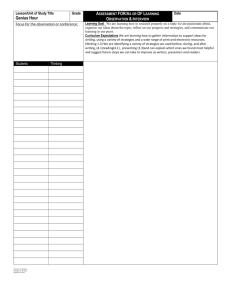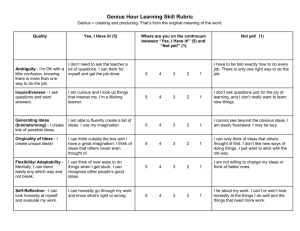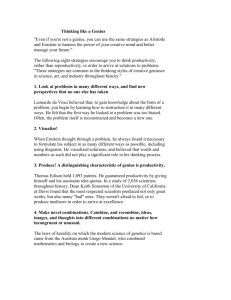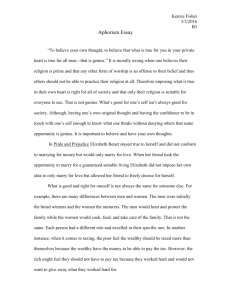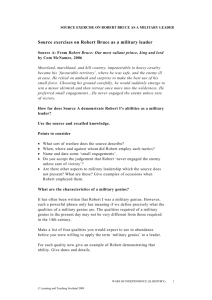thinking-genius-essay - Thinking Mathematics!
advertisement
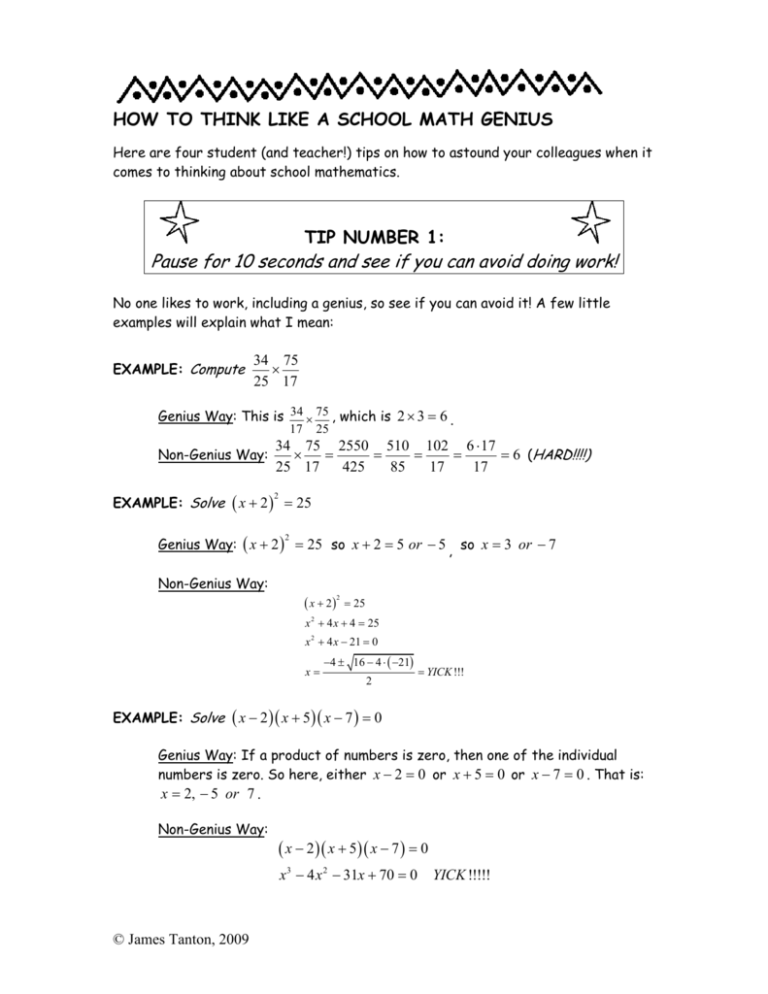
HOW TO THINK LIKE A SCHOOL MATH GENIUS Here are four student (and teacher!) tips on how to astound your colleagues when it comes to thinking about school mathematics. TIP NUMBER 1: Pause for 10 seconds and see if you can avoid doing work! No one likes to work, including a genius, so see if you can avoid it! A few little examples will explain what I mean: EXAMPLE: Compute 34 75 × 25 17 Genius Way: This is 34 × 75 , which is 2 × 3 = 6 . 17 25 34 75 2550 510 102 6 ⋅ 17 Non-Genius Way: × = = = = = 6 (HARD!!!!) 25 17 425 85 17 17 EXAMPLE: Solve ( x + 2) 2 = 25 Genius Way: ( x + 2 ) = 25 so x + 2 = 5 or − 5 , so x = 3 or − 7 2 Non-Genius Way: ( x + 2) 2 = 25 x + 4 x + 4 = 25 2 x 2 + 4 x − 21 = 0 x= EXAMPLE: Solve −4 ± 16 − 4 ⋅ ( −21) 2 = YICK !!! ( x − 2 )( x + 5)( x − 7 ) = 0 Genius Way: If a product of numbers is zero, then one of the individual numbers is zero. So here, either x − 2 = 0 or x + 5 = 0 or x − 7 = 0 . That is: x = 2, − 5 or 7 . Non-Genius Way: ( x − 2 )( x + 5)( x − 7 ) = 0 x3 − 4 x 2 − 31x + 70 = 0 © James Tanton, 2009 YICK !!!!! EXAMPLE: Compute 42 × 98 by hand Genius Way: 42 × 100 = 4200 and we are two 42s less than this. So the answer is 4200 − 84 = 4116 . Non-Genius Way: Do it via long multiplication. Sometimes it might not be possible to avoid work, but it is always worth the while to spend a moment to see if you can! SOME PRACTICE FOR YOU: Solve the following problems like a math genius. 82 70 90 × × 9 41 35 b) Compute 36 × 198 a) Compute c) Compute 999 × 174 d) Solve ( a + 2 ) = 8 3 e) Simplify ( x − a )( x − b ) ( x − c) ⋅ ⋯ ⋅ ( x − y )( x − z ) f) Is 33000 − 1 prime? g) A parabola passes through the points ( 2,5 ) , ( 3, −6 ) and (10,5 ) . What is the x -coordinate of its vertex? h) Solve x + 3 + 2 x + 3 = 8 . 1 simplify the expression: x 1 1+ 1 1+ 1 1+ 1 1+ 1 1+ 1 1+ 1 1+ 1 1+ 1 1+ x 4 (3 + h) − 81 h i) If x is a number that satisfies x = 1 + j) Find lim h →0 (Solutions appear at the end of this essay.) © James Tanton, 2009 TIP NUMBER 2: Don’t do work you are only going to undo! This is really just an extension of the previous tip, but it is worth making explicit as its own piece of advice. Why do work when you are only going to undo it? EXAMPLE: As a very simple, but common, example many students when asked to solve for x in x 10 = 5 13 will think “cross multiply” to write: 13x = 50 and then divide by 13 to get: x= 50 13 Why multiply by 13 in the first place if you are only going to divide by 13 later? Wouldn’t it be easier just to look at x= 10 50 ×5 = ? 13 13 QUICK PRACTICE FOR YOU: Solve for w in 60 = w 713 2 . 3 © James Tanton, 2009 x 10 = and multiply both sides by 5 to get 5 13 TIP NUMBER 3: Recognise when something is wrong! In your work it is always worth doing a quick check to see if what you are writing seems plausible. This can be as simple as: Is the answer in the right ball park? (e.g. 19 × 388 should be about 20 × 400 = 8000 ) Substituting in your answer. (e.g. I solved x 2 + 3 x = 5 and got x = 2 . But plugging back in x = 2 to check shows I am wrong) or as subtle as the following: EXAMPLE: My calculator says that 46 equals 6.782329983 Response: This must be wrong. If I multiply 6.782329983 (which ends with a three) by itself I must get an answer that ends with 3 × 3 = 9 . Thus 6.782329983 squared is not 46! EXAMPLE: My calculator shows that 178212 + 184112 and 192212 are equal. (CHECK THIS ON YOUR CALCULATOR TOO!) Response: This must be wrong. 1782 2 is even and 18412 is odd and so 12 178212 + 184112 will be odd. It cannot equal 1922 , which is even! EXAMPLE: When I plot the curve y = 200 on my calculator I see a vertical 1 + x4 asymptote at x = 0 . Response: This must be incorrect. Putting x = 0 into the formula is fine. (In fact, at x = 0 we have y = 200 .) © James Tanton, 2009 EXAMPLE: Tatiana says that 10! = 8542677640 Response: This must be wrong. 10! should end with at least two zeros since 10 × 9 × 8 × ⋯ × 2 × 1 contains one 10 and it also contains 2 × 5 which is a second 10. EXAMPLE: Professor Farkelsnark has invented a new function like sine, or logarithm, which he calls “ GLOB .” He claims that GLOB is always positive and satisfies: GLOB ( x + y ) = x 2 GLOB ( y ) + GLOB ( xy ) Response: This is impossible. Since x + y equals y + x the right hand side can’t be a formula that treats one variable differently from the other. The term x 2 GLOB ( y ) is treating x and y with different status. SOME PRACTICE FOR YOU: 1. Could 56452 × 18863 = 98611987364 be correct? 2. Could 2765532134 end with a seven? 3. Could the sum of 19000 odd numbers given an answer that ends with a five? 4. Explain why the formula (a + b) 4 = a 4 + b 4 + 4ab 3 + 6ba 3 + 4a 2 b 2 cannot be right. 5. With how many zeros does 20! end? 6. Sketch the graphs y = x 2 and y = 2 x simultaneously on a calculator to see they intersect twice. Is this right? Do they intersect exactly two times? 7. Find the area of a triangle with side lengths 9 inches, 8 inches and 19 inches. © James Tanton, 2009 TIP NUMBER 4: Meta-Analyse! Sometimes one can just tell what an answer has to be without doing any work. This doesn’t mean that one shouldn’t put in the effort to support the answer! But a math genius can be guided by knowing what the answer has to be, and so have an easier time of it. Here are some examples. You don’t need to know any of the mathematics behind these questions to make a genius guess as to what the answers must be. EXAMPLE: What is the value of x in this diagram? [All line segments are tangents.] Genius Response: The answer is probably 7 as this is the only number mentioned. EXAMPLE: 6726 professionals gather at a conference. Is it possible that 762 of these people took part in 234 handshakes, 55 people took part in 763 handshakes, 564 took part in 677 handshakes, 761 in 9 handshakes, 133 in 653 handshakes, and the rest in 988 handshakes? Genius Response: The answer is probably “no” as I sincerely doubt that I would be expected to demonstrate that a scenario with numbers like these can be true. EXAMPLE: Without a calculator, find an exact value for the angle y . © James Tanton, 2009 Genius Response: The answer is probably 90 . We won’t be expected to find a tricky answer without the aid of a calculator, and 90 is a nice number that is attainable in multiple ways. [The answer might also be 30 , 45 or 60 as these appear often in math problems, but only for specific groups of numbers.] EXAMPLE: Evaluate ∫ (x 300 −300 3 ( ) + 2 x 77 ) sin x 44 + 766 cos ( x 667 − x 2 ) dx . 101 Genius Response: There is no way I’d be expected to do anything with a formula as complicated as this. The answer must be a simple number. Since we have some symmetry involved (we’re dealing with a range from -300 to 300) we need a “symmetrical” answer. It is most likely 0. SOME PRACTICE FOR YOU: What are the most likely answers to the following problems. 1. Find a pair of positive numbers x and y that sum to 50 and give the largest possible value for the product xy . 2. Albert has a piece of string 40 inches long and uses it for the perimeter of a rectangle. What are the dimensions of the rectangle he could produce possessing the largest possible area? 3. Of all shapes of area 1, which has the smallest perimeter? 4. Find all positive integers a , b and c that satisfy a117 + b117 = c117 . 5. In how many ways can one tile an 8 × 8 checkerboard with 2 × 1 dominos if the top left corner cell of the checkerboard is removed, as is the bottom right corner? 6. The quantity log b x is defined to be: “The power of b that gives the answer x .” What then is: a) b log b x ( ) b) log b b x (A genius doesn’t need to know any log rules to think her way through these!) © James Tanton, 2009 ANSWERS: TIP 1: 82 70 90 90 70 82 × × = × × = 10 × 2 × 2 = 40 9 41 35 9 35 41 b) 36 × 198 = 36 × 200 − 72 = 7200 − 72 = 7128 c) 999 × 174 = 1000 × 174 − 174 = 173,826 a) d) From ( a + 2 ) = 8 we get a + 2 = 2 so a = 0 . 3 e) ( x − a )( x − b ) ( x − c) ⋅ ⋯ ⋅ ( x − y )( x − z ) = 0 because x − x = 0 is part of the product. f) 31000 is odd, and so 31000 − 1 is even and not prime. g) A parabola is a symmetrical U-shaped curve. Since x = 2 and x = 10 give the same output, the vertex must be at x = 6 . h) ( x+3 and so ) 2 + 2 x + 3 + 1 = 9 , so ( ) x + 3 +1 2 = 9 giving x + 3 + 1 = 3 or − 3 , x + 3 = 2 or − 4 . We must reject the second solution (as the radix symbol means positive root) and so x + 3 = 22 , giving x = 1 . i) 1 1+ =x 1 1+ 1 1+ 1 1+ 1 1+ 1 1+ 1 1+ 1+ 1 1+ 1 x (Look at the bottom and work your way up!) j) This is the derivative of f ( x ) = x 4 at x = 3 , and so the answer must be 4x 3 at x = 3 . That is, the answer is 108. TIP 2: 2 × 60 60 w 40 = w= 3 = If 713 2 , then 713 713 . 3 © James Tanton, 2009 TIP 3: 1. The product should end with a 6, not a 4. 2. A non-trivial power of two is even and so cannot end with a seven. 3. The sum of an even number of odds is sure to be even. The sum cannot end with a 5. 4. There is asymmetry with the right side. This cannot be correct. 5. Four 6. They intersect three times. (Check far to the right.) 7. This triangle does not exist. (9 and 8 do not “reach” across 19.) TIP 4: 1. This problem is symmetrical in the two variables, The answer is probably the symmetric answer with both x and y equal to 25. 2. The use of word ”the” suggests there is just one answer. The only rectangle that stands out in a distinguishable way is a square. 3. Probably the most symmetrical shape, a circle, is the answer. 4. Raising to the 117th power seems absurd. As I can’t see any obvious answers, it is probably the case that there are no solutions. 5. This sounds complication. The answer is probably none. 6. Since log b x is “the power of b that gives the answer x ,” if we use it as a power of b we must get the answer … x !! Thus b logb x = x . ( ) Obviously the power of b that gives the answer b x is … x!! Thus log b b x = x . QUESTION: Who is Mable’s daughter’s mother? © James Tanton, 2009


